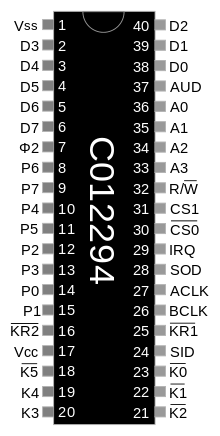Atari POKEY
The Potentiometer and Keyboard Integrated Circuit ( POKEY ) is a special electronic component from the US manufacturer Atari. It can be found in the Atari 400 , Atari 800 home computers , the models of the XL and XE series and in the Atari 5200 game console . It has also been installed in some Atari arcade machines and is part of a few game modules for the Atari 7800 game console . Various electronic function groups are combined in the POKEY: the tone generation, the keyboard query and the operation of the serial interface for communication with the corresponding peripheral devices.
Technical specifications
The POKEY has four sound channels (voices), each of which can generate a square wave (tone color) with freely adjustable amplitude (tone strength, envelope) and frequency (pitch). In addition, sound channels can be interconnected in pairs, which enables further influences (mixing, filtering) of the synthesized sounds. In cooperation with the CPU, the POKEY also enables digitized signals ( samples ) to be played back, for example speech previously recorded with an external analog-to-digital converter ( sampler ). However, the CPU computing power required for this is considerable, so that game authors in particular often resorted to the limited but time-saving synthetic sound generation. All tones provided, including those possibly initiated externally by the data recorder, are then fed into the RF modulator for output to the connected television set.
The keyboard is also queried with the POKEY; In addition, it also has timer functions and random number generators (pseudo-noise) .
literature
- Julian Reschke, Andreas Wiethoff: The Atari professional book. Sybex-Verlag GmbH, Düsseldorf, 1986, ISBN 3-88745-605-X
- Eichler, Grohmann: Atari 600XL / 800XL Intern. Data Becker GmbH, 1984, ISBN 3-89011-053-3
